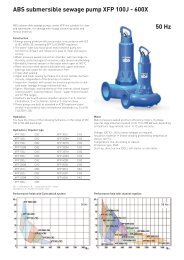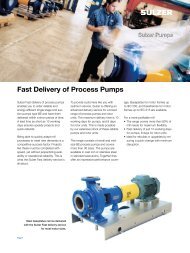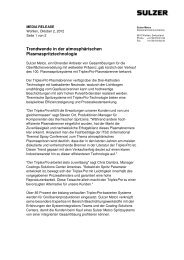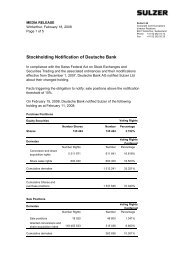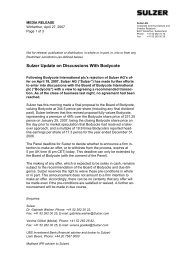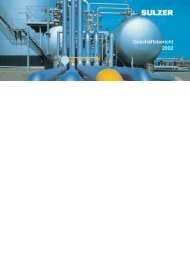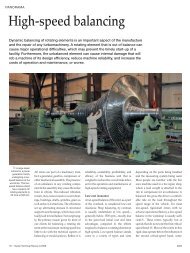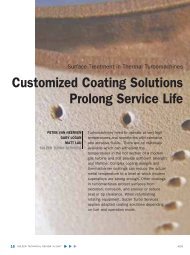Testing and quality
Testing and quality
Testing and quality
You also want an ePaper? Increase the reach of your titles
YUMPU automatically turns print PDFs into web optimized ePapers that Google loves.
ment as a function of suction pressure<br />
or NPSH. For this purpose, model<br />
pumps are equipped with large windows<br />
allowing visual access to the entire eye<br />
of the suction impeller over 360°. Sulzer<br />
Pumps uses the high competencies of<br />
Sulzer Innotec in complex NC machining<br />
for the production of these model<br />
pumps. These skills are needed to successfully<br />
machine the complex 3D<br />
contours of casings <strong>and</strong> impellers out<br />
of solid blocks of aluminum.<br />
The window at the suction side allows<br />
the experimental confirmation of the<br />
suction pressure at which the first<br />
bubbles are visible on the vane surface<br />
at all positions of the impeller within<br />
the pump inlet casing. It also allows the<br />
identification of the cavitation length for<br />
a given suction pressure <strong>and</strong>, consequently,<br />
the estimation of the according<br />
risk of erosion.<br />
Because the pressure side of the vane<br />
is not visible in the impeller eye if fully<br />
metallic vanes are used, in order to also<br />
confirm the cavitation development on<br />
the pressure side of the vanes, one or<br />
two vanes of the development impellers<br />
are machined from acrylic glass. The estimation<br />
of cavitation is especially important<br />
for large injection pumps for the<br />
petroleum industry or for large boiler<br />
feed pumps for thermal power plants<br />
for which the suction energy <strong>and</strong> the<br />
risk of cavitation erosion may be very<br />
high.<br />
6 Subsea test bed at Sulzer facility in Leeds, UK.<br />
Focus on prototype performance<br />
When a model pump is used in the development<br />
of new suction impellers for<br />
these applications, it is designed at prototype<br />
scale. This procedure allows the<br />
job impellers to be tested in order to<br />
confirm cavitation-free operation on site.<br />
Because of the presence of a window<br />
that limits the suction pressure, as a compromise,<br />
tests are performed at a<br />
reduced speed compared with site conditions,<br />
<strong>and</strong> the full-speed performance<br />
is calculated using st<strong>and</strong>ard affinity<br />
laws.<br />
The development test bed is also used<br />
to check the mechanical performance of<br />
key elements of pumps, such as bearings<br />
or seals. For example, dedicated testing<br />
equipment has been developed in order<br />
to test different material combinations<br />
for the product-lubricated line shaft<br />
bearings under real site conditions using<br />
water charged with s<strong>and</strong>.<br />
Prepared for future dem<strong>and</strong>s<br />
Sulzer Pumps continuously develops<br />
<strong>and</strong> improves the testing methods for<br />
new products <strong>and</strong> for machines. For<br />
example, the dem<strong>and</strong> for subsea<br />
pumping is growing, along with the<br />
requirements that pumps operating<br />
under water have to fulfill. To be able<br />
to test subsea processing equipment<br />
under realistic conditions, Sulzer is<br />
investing in a dedicated multiphase<br />
subsea test bed in the UK. This state-ofthe-art<br />
addition to the already impressive<br />
string testing facilities in Leeds 5 will<br />
position Sulzer as the market leader with<br />
respect to pump-testing facilities. In this<br />
installation, it will be possible to<br />
examine subsea pump/motor packages<br />
with weights approaching 100 tons in<br />
water depths of up to 10 m 6.<br />
When deployed in the open ocean,<br />
these pumps will operate in many kilometers<br />
of water depth <strong>and</strong> are designed<br />
to take high external <strong>and</strong> internal pressures<br />
whilst delivering the high pressure<br />
rises that customers require. The first<br />
pump that will be tested once the test<br />
bed is commissioned will be a 3 MW,<br />
6000 rpm multiphase pump able to<br />
deliver over 100 bar pressure rise—well<br />
suited for many of the current subsea<br />
applications.<br />
Current specifications <strong>and</strong> market<br />
ideas set the st<strong>and</strong>ards for capabilities<br />
<strong>and</strong> capacity of any new test bed. Sulzer,<br />
however, follows the motto “designing<br />
for the future” <strong>and</strong> requires that new<br />
test installations must consider future<br />
possibilities for expansion. Sulzer thereby<br />
plans to keep these investments operational<br />
<strong>and</strong> useful for many years, as both<br />
products <strong>and</strong> markets mature <strong>and</strong> adapt.<br />
This philosophy makes it possible for<br />
Sulzer Pumps to deliver pumps adapted<br />
to market <strong>and</strong> client requirements now<br />
<strong>and</strong> in future years.<br />
TESTING AND QUALITY<br />
Matt Bourne<br />
Sulzer Pumps (UK) Ltd.<br />
Manor Mill Lane<br />
Leeds, LS11 8BR<br />
UK<br />
Phone +44 113 272 5704<br />
matt.bourne@sulzer.com<br />
Matti Koivikko<br />
Sulzer Pumps Finl<strong>and</strong> Oy<br />
P.O.Box 66<br />
48601 Kotka<br />
Finl<strong>and</strong><br />
Phone +358 50 555 0268<br />
matti.koivikko@sulzer.com<br />
Philippe Dupont<br />
Sulzer Pumps Ltd.<br />
Zürcherstrasse 12<br />
8401 Winterthur<br />
Switzerl<strong>and</strong><br />
Phone +41 52 262 40 30<br />
philippe.dupont@sulzer.com<br />
Sulzer Technical Review 1/2011 |<br />
9



